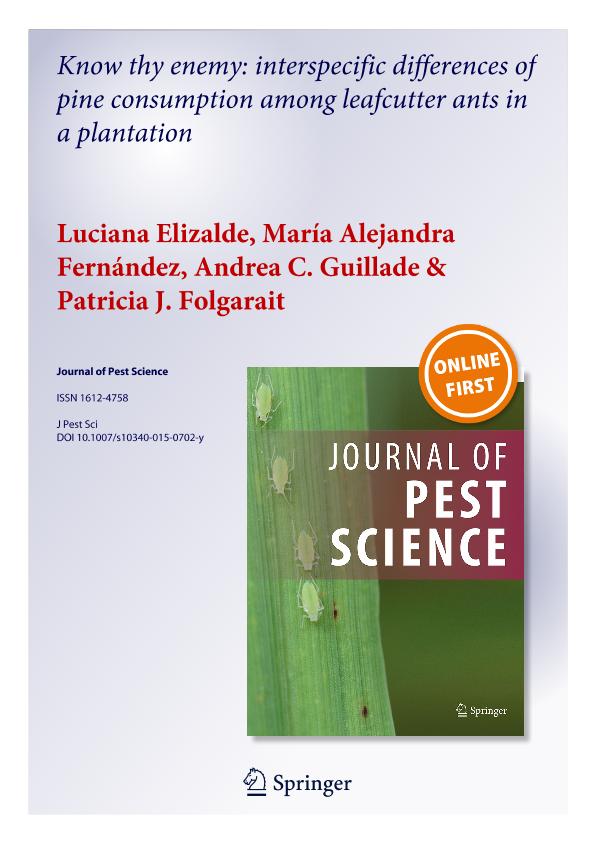Mostrar el registro sencillo del ítem
dc.contributor.author
Elizalde, Luciana

dc.contributor.author
Fernández, María Alejandra

dc.contributor.author
Guillade, Andrea Cecilia

dc.contributor.author
Folgarait, Patricia Julia

dc.date.available
2019-02-07T17:22:26Z
dc.date.issued
2016-06
dc.identifier.citation
Elizalde, Luciana; Fernández, María Alejandra; Guillade, Andrea Cecilia; Folgarait, Patricia Julia; Know thy enemy: interspecific differences of pine consumption among leafcutter ants in a plantation; Springer Heidelberg; Journal of Pest Science; 89; 2; 6-2016; 403-411
dc.identifier.issn
1612-4758
dc.identifier.uri
http://hdl.handle.net/11336/69644
dc.description.abstract
The damage to plantations by pests is often determined by perceptions rather than objective data, resulting in excessive use of pesticides. Leafcutter ants are considered important pests to plantations in America. We evaluated the difference in Pinus taeda biomass consumption by four Acromyrmex leafcutter ant species which co-inhabit plantations of this pine species. These ants exhibit morphological and behavioral differences, i.e., Ac. heyeri has mandibles adapted to cut monocots, while the other species cut dicots, which may result in differences in their consumption of pine. We collected the plant biomass that ants carried into their nests and recorded the foraging activity in different seasons throughout a year. The P. taeda biomass carried into leafcutter nests was less than 20 % compared to total plant biomass. Colonies with greater foraging activity carried a greater amount of total biomass, but they did not carry more pine biomass. The leafcutter ant species studied differed in their use of pine biomass, but not of total biomass. Acromyrmex ambiguus and Ac. crassispinus were the species carrying the greatest amount of pine biomass and with more colonies using pine, whereas very little amounts of pine were carried by Ac. heyeri and by very few colonies. Thus, leafcutter ant species do not cause the same damage to pine plantations. Our results also highlight the importance of pest management strategies based on a thorough knowledge of the biology of the species, including those characteristics which can predict the use that each species will make of the plantation.
dc.format
application/pdf
dc.language.iso
eng
dc.publisher
Springer Heidelberg

dc.rights
info:eu-repo/semantics/openAccess
dc.rights.uri
https://creativecommons.org/licenses/by-nc-sa/2.5/ar/
dc.subject
Acromyrmex
dc.subject
Forestation
dc.subject
Pest Species
dc.subject
Pinus Taeda
dc.subject
Species Traits
dc.subject.classification
Otras Ciencias Biológicas

dc.subject.classification
Ciencias Biológicas

dc.subject.classification
CIENCIAS NATURALES Y EXACTAS

dc.title
Know thy enemy: interspecific differences of pine consumption among leafcutter ants in a plantation
dc.type
info:eu-repo/semantics/article
dc.type
info:ar-repo/semantics/artículo
dc.type
info:eu-repo/semantics/publishedVersion
dc.date.updated
2019-02-05T19:53:28Z
dc.journal.volume
89
dc.journal.number
2
dc.journal.pagination
403-411
dc.journal.pais
Alemania

dc.journal.ciudad
Heidelberg
dc.description.fil
Fil: Elizalde, Luciana. Consejo Nacional de Investigaciones Científicas y Técnicas. Centro Científico Tecnológico Conicet - Patagonia Norte. Instituto de Investigaciones en Biodiversidad y Medioambiente. Universidad Nacional del Comahue. Centro Regional Universidad Bariloche. Instituto de Investigaciones en Biodiversidad y Medioambiente; Argentina. Universidad Nacional de Quilmes. Departamento de Ciencia y Tecnología; Argentina
dc.description.fil
Fil: Fernández, María Alejandra. Universidad Nacional de Quilmes. Departamento de Ciencia y Tecnología; Argentina
dc.description.fil
Fil: Guillade, Andrea Cecilia. Consejo Nacional de Investigaciones Científicas y Técnicas; Argentina. Universidad Nacional de Quilmes. Departamento de Ciencia y Tecnología; Argentina
dc.description.fil
Fil: Folgarait, Patricia Julia. Consejo Nacional de Investigaciones Científicas y Técnicas; Argentina. Universidad Nacional de Quilmes. Departamento de Ciencia y Tecnología; Argentina
dc.journal.title
Journal of Pest Science

dc.relation.alternativeid
info:eu-repo/semantics/altIdentifier/doi/https://dx.doi.org/10.1007/s10340-015-0702-y
dc.relation.alternativeid
info:eu-repo/semantics/altIdentifier/url/https://link.springer.com/article/10.1007/s10340-015-0702-y
Archivos asociados
